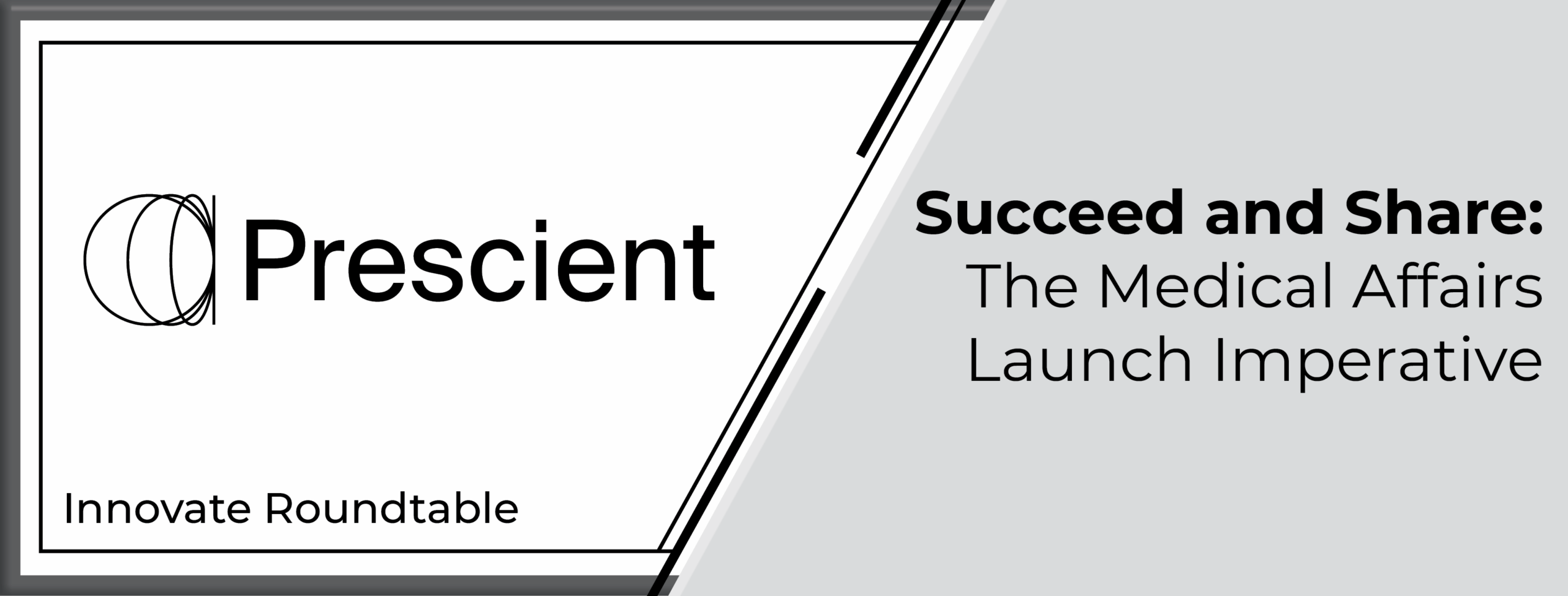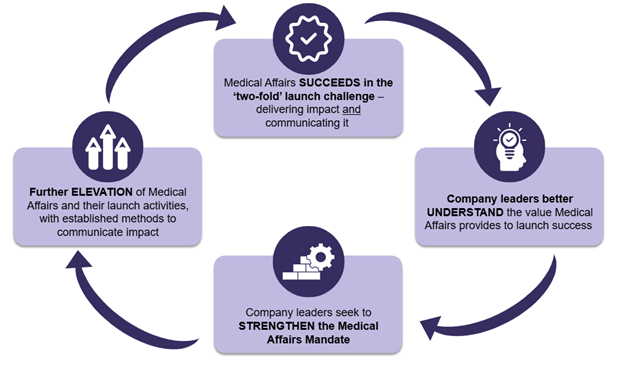Industry Co-authors
- Mark Weintraub, US Field Medical Strategy, Novartis
- Kevin Voelker, National Director Virtual Engagement MSLs and Field Medical Excellence, US, Novartis
- Karen V. Pinette, Medical Affairs & HEOR Strategic Operations, SAGE Therapeutics
- Bagrat Lalayan, previously at Eisai in Global Medical Strategy
- Vanessa Johnson, Global Medical Excellence, Gilead
Prescient Co-Authors
- Katy Chun, Vice President, Prescient
- Carly Maide, Director, Prescient
- Kevin Michels, Consultant, Prescient
Disclaimer: The views and opinions expressed in this article are solely those of the individual and do not represent or reflect any official policies or positions of their employers.
I. Background
Launch can be a make-or-break proposition for a molecule’s prospects and ability to deliver on its promise to patients. In today’s increasingly complex clinical landscapes, a successful launch remains crucial and challenging. Due to their unique capabilities and involvement across the lifecycle, Medical Affairs professionals can play a critical role in launch preparation and success.
Medical Affairs can provide differential launch support in many ways, including:
- Conducting early HCP engagement and education ahead of deploying other functional partners
- Providing trusted and peer-level scientific exchange, enabling a thorough understanding of the disease state and education on key elements of the patient journey and healthcare ecosystem
- Leading pre-launch efforts to identify and address potential barriers for patients and providers across the treatment journey
- Developing comprehensive and integrated Evidence Generation Plans
- Communicating insights into the organization to inform launch priorities and ensure healthcare landscape-aligned strategy in the lead-up to launch
If you are nodding your head, you might have supported a similar launch activity and can recall how that effort supported success. Although the connection between Medical Affairs activity and launch success might feel intuitive, industry peers with more limited Medical Affairs familiarity may struggle to connect the dots. Therefore, the launch challenge for Medical Affairs becomes two-fold. Medical Affairs teams must not only elevate the quality of launch activities to keep pace with the evolving landscape but also capture and communicate the value and impact of those activities to the broader organization.
Sound like a Herculean task?
Medical Affairs teams that achieve the double aim of demonstrating excellence and effectively communicating it pave the way for launch success (Figure 1).
Figure 1: Positive reinforcement loop of Medical Affairs demonstrating excellence and communicating impact
At the March 2025 MAPS Americas Meeting, Prescient hosted a roundtable discussion with a diverse set of Medical Affairs leaders to discuss this pressing topic. Continue reading for key considerations when you or your team are gearing up for launch and striving to meet the double aim of succeeding and sharing.
II. Succeed
When developing and executing your next program of Medical Affairs launch strategy, it can be a valuable exercise to step back and consider: how can we be more targeted, forward-looking, collaborative and dynamic?
TARGETED
- Success follows strategy. Strategy follows a plan.
- Medical Affairs teams can provide massive value to the organization long before launch activities begin by leveraging their scientific and landscape expertise to identify strategic priorities for launch success, establishing themselves as a valued strategic partner in the process
- Medical Affairs launch strategy lives within a defined plan, which can then be integrated and aligned with other strategic documents (e.g., cross-functional launch plan or scientific narrative), becoming a living document that can reflect the targeted, forward-looking, collaborative and dynamic principles highlighted below
- More ≠ better for Medical Affairs-led launch activities and engagement
- Remember that HCPs value Medical Affairs for objective, high-quality scientific and medical information and education
- Resist the urge to treat HCP interactions as a checkbox metric; fewer substantive interactions with intention can be more meaningful than more discussions with less to say in each
- Acknowledge and account for fundamental differences across external stakeholders, especially in the community setting
- Community physicians often represent the majority of treaters in many therapeutic areas
- Medical teams may adopt more familiar academic-oriented approaches, neglecting distinct community preferences and needs
- Incorporating a ‘community mindset’ strengthens Medical Affairs engagement effectiveness, including emphasis on productivity with limited time, investment in reactive resources, deployment of different field-facing teams (e.g., supplemental ‘launch’ MSLs or virtual MSLs) and optimizing cross-functional coordination
- Understanding key regional variations (e.g., regulatory requirements, patient journey nuances and HCP needs and expectations) and embedding flexibility with the Medical launch strategy to account for these differences
FORWARD-LOOKING
- Medical Affairs has the ability to anticipate stakeholder needs and understand the scientific and medical evidence that will resonate and be required in tomorrow’s clinical landscape
- Medical Affairs teams can take a leadership role to define a durable and meaningful product narrative that considers long-term landscape shifts and contributes to aligning priorities for additional evidence generation that are informed by their early insight gathering
- Product narratives should go hand-in-hand with the Medical launch strategy and plan, ensuring that internal priorities and external-facing communication are in sync
- Medical Affairs is also uniquely positioned to drive long-term portfolio value by helping bridge numerous product launches within a therapeutic area, ensuring alignment and consistency in goals, messaging and quality from one launch to the next
COLLABORATIVE
- Collaboration is a requirement, not a luxury
- Connect early to succeed together
- Medical Affairs should connect with Compliance and other functions early and involve them in the ‘solutioning’ of launch activities and metrics; a quick conversation can transform assumed no-gos into a reality!
- Establish ‘One Company’ voice
- Establishing consistent bi-directional communication with cross-functional colleagues early in the launch planning process ensures alignment of launch strategy and functional tactics and reinforces cross-functional awareness, culminating in a highly visible and consulted launch plan
- This tight-knit coordination ensures priorities are aligned across functions and ensures clear communication to the medical community, strengthening HCP trust and confidence in the organization
- Launch success is a full, cross-functional team effort
- Ensure cross-functional teams focus on what matters most: The why behind the collaboration, in addition to the how
- Prioritize understanding the larger goal: Launch impact on patient outcomes in totality vs. hyper-focusing on function- or tactic-specific impact measures
DYNAMIC
- Embrace change: Be proactive and plan for it
- Given the high stakes, rapid changes and limited data that characterize launch environments, decision making becomes both an art and science
- Medical teams can translate their deep understanding of HCP needs into thoughtful ‘if X, then Y’ scenarios and decision trees that enable proactive leadership, putting the organization on the forefront to navigate decision making (e.g., if data are better than expected, then benefit-risk narrative can be adjusted in this manner)
- Anchor to data that are available (e.g., early insights, analog launches and real-world evidence) and establish mechanisms to review evolving insights in real-time (e.g., AI analytics, dashboards combining MSL feedback and HCP sentiment) to drive agile decision making
- Don’t be afraid to pivot; establish structured feedback loops to reassess decisions and adapt as needed
III. Share
While elevating how Medical Affairs teams contribute to launch excellence is essential, it’s only part of the story. To unlock sustainable momentum and success, Medical Affairs teams must thoughtfully capture and communicate the impact achieved. Our roundtable discussion identified several ways that Medical Affairs teams can think about measuring and communicating impact.
- A baseline is your best friend
- Randomized, controlled data are a familiar concept; not only are they the backbone of drug approvals, but they can be a useful template for demonstrating the comparative value of a Medical Affairs-led launch initiative
- Establish a baseline and aim to compare an activity with and without a Medical Affairs launch intervention (e.g., track the difference in time to trial site issue resolution at sites with a supportive Medical Affairs resolution mechanism in place vs. without)
- Other examples that could be used to demonstrate Medical Affairs impact include trial site selection optimization, successful trial recruitment, guideline-adherent care support and HCP sentiment
- Impact is defined by objective
- Readers who have attempted to measure ‘impact’ for Medical Affairs have likely run into three familiar hurdles:
- An abundance of traditional metrics that capture what activities (e.g., number of MSL interactions and number of publications) have guided stakeholder behavior, but not necessarily how that behavior impacts the overall objective and why it is important
- Data acquisition and analysis challenges, including imprecision, cost, or collection duration, that make a holistic assessment of outcome improvement difficult
- Change takes time. The impact of a pre-launch educational activity on HCP behavior will take a long time, therefore, and requires consistent, durable tracking mechanisms and managing expectations of internal stakeholders accordingly
- These hurdles may be cleared in a few ways…
- Ensure strategic objectives are clear, with well-defined measurable outcomes
- Connect the right activity to the desired outcome. The contribution of the activity to the outcome should be clear to create a compelling value story
- Think outside the box and consider patient-oriented metrics that focus on the greater goal of improving outcomes. Approaches with accessible data exist; examples include connecting medical interventions (e.g., scientific exchange or medical education) to:
- Impacting identified care gaps through improved screening or diagnosis rates for disease, guideline compliant care
- Increasing HCP awareness of data
- Shifting HCP perceptions
- Be strategic advisors for your organization
- Optimized communication is not a one-way street; Medical Affairs teams should consider their leadership’s preferences but may also present metrics as a simple framework that considers:
- The right issue to measure
- The right target audience to demonstrate impact
- The right frequency to measure and communicate the metrics
- Along the way, recalibration of leadership expectations to feasibility or strategic shifts might be required (i.e., 30 MSL visits a day is not a feasible or impactful metric or target)
- Know your story and lean into the collective effort
- Given the many factors influencing external stakeholder behavior, impact assessment is an inherently imprecise exercise (e.g., was treatment decision impacted by a recent data publication, by recent material interaction, both, or none?)
- In the face of this ambiguity, recognizing that Medical Affairs contributions are multi-factorial but not mutually exclusive and developing comfort with linking foundational launch activities (e.g., increasing diagnosis rate) to launch and company success is a necessary first step
IV. Conclusion
Medical Affairs professionals and teams are uniquely positioned to drive launch success and have the capability to effectively capture and communicate the value they deliver to their organizations. We hope these perspectives help your teams achieve this challenging but rewarding double aim in your next launch!
In addition to the co-authors of this piece, Prescient would like to thank the following individuals for their roundtable participation:
- Alex Chen, Medical Excellence and Impact, Johnson and Johnson
- Elise Blankenship, Medical Excellence, Ipsen
INTERESTED IN HOSTING A ROUNDTABLE?
This article summarizes a Roundtable hosted by a MAPS Partner Circle member that brought together leading experts from across the industry. If you are a solution provider interested in hosting your own Roundtable, please check out our Media Planner or contact Luke with MAPS: [email protected].




